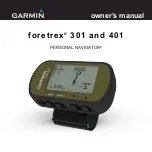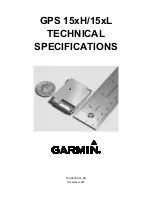
6
The receiver amplifies this return signal, or echo, and sends it to the
display, where an image of the object appears on the scrolling sonar
chart. The sonar's microprocessor calculates the time lapse between the
transmitted signal and echo return to determine the distance to the
object. The whole process repeats itself several times each second.
Your unit can record a log of the sonar signals that scroll across the
screen and save them to the MMC memory card. (These recordings are
also called sonar charts or sonar graphs.) You can replay this sonar log
in the unit using the Sonar Simulator function, or play it back on a per-
sonal computer using our free Sonar Viewer. The viewer is available for
download from the Lowrance web site, www.lowrance.com.
You can save several different sonar log files, erase 'em and record new
ones, over and over again. The size of your sonar recordings is only lim-
ited by the free space available on your MMC.
How Lowrance GPS Works
You'll navigate faster and easier if you understand how your unit scans
the sky to tell you where you are on the earth — and, where you're go-
ing. (But if you already have a working understanding of GPS receivers
and the GPS navigation system, skip ahead to Section 2,
Installation &
Accessories
on page 13. If you're new to GPS, read on, and you can later
impress your friends with your new-found knowledge.)
First, think of your unit as a small but powerful computer. (But don't
worry — we made the unit easy to use, so you don't need to be a com-
puter expert to find your way!) It includes a keypad and a screen with
menus so you can tell it what to do. The screen also lets the unit show
your location on a moving map, as well as point the way to your desti-
nation.
This gimbal-mounted unit uses an external antenna/receiver module,
which makes the whole system work something like your car radio. But
instead of your favorite dance tunes, this receiver tunes in to a couple
of dozen GPS satellites circling the earth. (It will also listen in to the
WAAS satellites in orbit, but more about that in the upcoming segment
introducing you to GPS and WAAS.)
Your unit listens to signals from as many satellites as it can "see"
above the horizon, eliminates the weakest signals, then computes its
location in relation to those satellites. Once the unit figures its latitude
and longitude, it plots that position on the moving map shown on the
screen. The whole process takes place several times a second!
Содержание LMS-522c iGPS
Страница 22: ...12 Notes ...
Страница 52: ...42 Notes ...
Страница 110: ...100 Notes ...
Страница 198: ...188 Notes ...
Страница 212: ...202 Notes ...
Страница 238: ...228 Notes ...
Страница 243: ...233 Notes ...
Страница 244: ...234 Notes ...
Страница 245: ...235 Notes ...















































